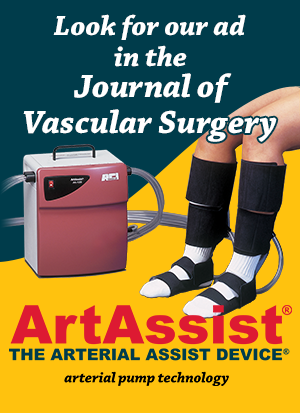According to a new review in the Journal of Vascular Surgery, Intermittent Pneumatic Compression therapy to treat peripheral artery disease has so far seen promising results. However, Sheldon et al. believe there is much more to be explored if IPC device makers intend to optimize their machines for PAD.
This new review highlights the need for researchers to identify what physiological and molecular mechanisms are responsible for successful IPC therapy. Although the improvement of vascular circulation is an important factor in determining whether or not an arterial IPC device is effective, the authors of this review suggest that improving responses on a deeper level would bring IPC therapy to new heights.
 Among the IPC devices referenced in this review is the ArtAssist® device model AA-1000. Find the entire published review in the Journal of Vascular Surgery December 2013 issue.
Among the IPC devices referenced in this review is the ArtAssist® device model AA-1000. Find the entire published review in the Journal of Vascular Surgery December 2013 issue.
Read the abstract here or download the PDF:
New Insights into the Physiologic Basis for Intermittent Pneumatic Limb Compression as a Therapeutic Strategy for Peripheral Artery Disease
Ryan D. Sheldon, MS, Bruno T. Roseguini, PhD, M. Harold Laughlin, PhD, and Sean C. Newcomer, PhD. Columbia, Mo; São Paulo, Brazil; and San Marcos, Calif. Journal of Vascular Surgery 2013; 58:1688-96.
The capability for externally applied rhythmic limb compressions to improve the outcomes of patients with peripheral artery disease has been recognized for nearly a century. Modern technology has permitted the development of portable and cost-effective intermittent pneumatic compression (IPC) systems to be made readily available for affordable at-home use. Mounting clinical evidence attests to the effectiveness of this strategy, with improvements in claudication distance rivaling those seen with exercise training or pharmacologic interventions, or both. However, owing to a lack of mechanistic knowledge, whether current application protocols are optimized for clinical outcomes is unknown. Traditional thinking has suggested that IPC transiently elevates blood flow, which is purported to relieve ischemia, improve vascular function, and promote vascular remodeling. Surprisingly, much ambiguity exists regarding the physiologic stimuli and adaptations that are responsible for the clinical effectiveness of IPC treatment. This review presents and critically discusses emerging evidence that sheds new light on the physiologic and molecular responses to IPC therapy. These novel findings highlight the importance of characterizing the phasic changes in the hemodynamic profile during IPC application. Further, these studies indicate that factors other than the elevation in blood flow during this therapy should be taken into account when designing an optimal IPC device. Lastly, we advance the hypothesis that manipulation of IPC stimulation characteristics could potentially magnify the documented clinical benefits associated with this therapy. In conclusion, recent evidence challenges the physiologic basis on which current IPC systems were designed, and further research to elucidate the basic and clinical outcomes of alternate stimulation characteristics is necessary.




